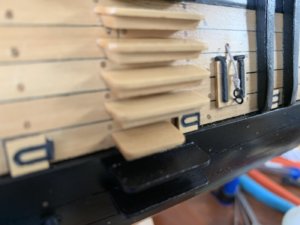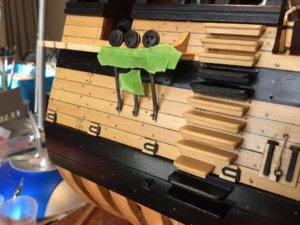Thanks, Mike! Fortunately I only had to make 8 blocks total! Even those few took about 2 hours to do, with parts squirting out of my fingers onto the floor as I tried to sand the blocks to shape. Imagine hand making blocks for a fully rigged ship!
-

Win a Free Custom Engraved Brass Coin!!!
As a way to introduce our brass coins to the community, we will raffle off a free coin during the month of August. Follow link ABOVE for instructions for entering.
-

PRE-ORDER SHIPS IN SCALE TODAY!
The beloved Ships in Scale Magazine is back and charting a new course for 2026!
Discover new skills, new techniques, and new inspirations in every issue.
NOTE THAT OUR FIRST ISSUE WILL BE JAN/FEB 2026
- Home
- Forums
- Ships of Scale Group Builds and Projects
- Group Build Archives
- Blandford Cross Section PoF Group Build
You are using an out of date browser. It may not display this or other websites correctly.
You should upgrade or use an alternative browser.
You should upgrade or use an alternative browser.
DocBlake's HMS Blandford Cross Section Build - 1/32 Scale - [COMPLETED BUILD]
Very nice blocks, Dave! ...and yes, when parts from the kit look great and fit well - is great, but a bit different joy when you make parts on your own. I can feel this enjoyment! 
The scratch builder must be made them all, even for a fully rigged ship, even for a three-decker... that's WOW
The scratch builder must be made them all, even for a fully rigged ship, even for a three-decker... that's WOW
- Joined
- Dec 3, 2018
- Messages
- 2,451
- Points
- 538

Good explanation Dave, Question, do you thin the linseed oil with turpentine before using it ?, the oil then penetrates better into the wood and becomes easier to apply, it may get a little lighter and the turpentine smells very much, BDW, nice result.
.
.
No need to thin the linseed oil, Knut. Soak the blocks about 30 seconds or so, then blot them dry with absorbent paper towels. They will dry hard in 24 hours!
Blocks look great Dave! You always go the extra mile and it always pays off.
Thanks, guys!
DO NOT KNOW HOW YOU DO IT 9BY GODS GIFT TO YOU) JUST BREATHTAKING. Don
Thanks for the kind words, guys!
This is the sequence for making the deadeye stropping and chain plates. This style of chain plate was in use by the British Royal navy before 1760. Blandford was launched in 1720.
I started with a length of 18 gauge copper wire (adjust based on scale and deadeye size). I wrapped it around the deadeye (a sacrificial deadeye, not the final one) and then clamped the two wires about 3/16" from the deadeye with a pair of pliers. With another pliers I squeezed the two wires between the first pair of pliers and the deadeye to create a tight strop with two parallel copper wires.
I then soldered the two copper wires together. Be careful not to solder too close to the deadeye or you won't be able to remove it. Once soldered, remove the sacrificial deadeye (you can use it again!).
File the soldered "strap" flat and remove any excess solder.
Blacken the chainplate and install the finish deadeye. Mine were dyed black.
Bend the chainplate to fit the channel and butt up against the hull. Drill a hole in the end of the chainplate, and with an awl mark the location on the hull where you'll pin the chainplate. Use the hole in the chainplate to mark the location. Drill that hole.
Install the chainplate/deadeye assembly.
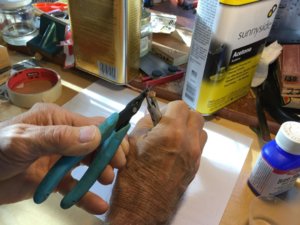
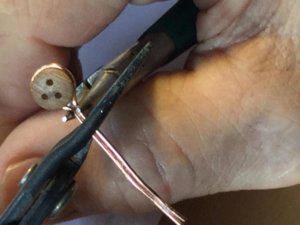

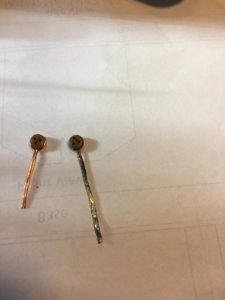
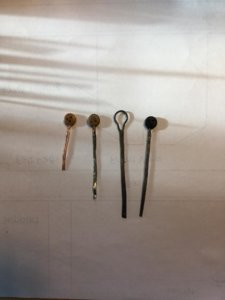
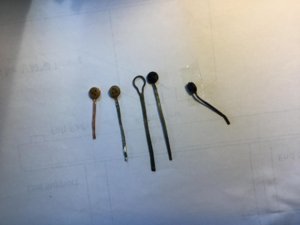
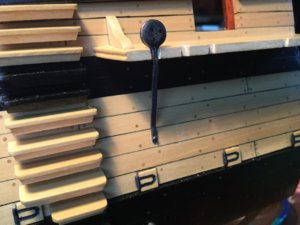
I started with a length of 18 gauge copper wire (adjust based on scale and deadeye size). I wrapped it around the deadeye (a sacrificial deadeye, not the final one) and then clamped the two wires about 3/16" from the deadeye with a pair of pliers. With another pliers I squeezed the two wires between the first pair of pliers and the deadeye to create a tight strop with two parallel copper wires.
I then soldered the two copper wires together. Be careful not to solder too close to the deadeye or you won't be able to remove it. Once soldered, remove the sacrificial deadeye (you can use it again!).
File the soldered "strap" flat and remove any excess solder.
Blacken the chainplate and install the finish deadeye. Mine were dyed black.
Bend the chainplate to fit the channel and butt up against the hull. Drill a hole in the end of the chainplate, and with an awl mark the location on the hull where you'll pin the chainplate. Use the hole in the chainplate to mark the location. Drill that hole.
Install the chainplate/deadeye assembly.







Many thanks for the step-by-step tutorial of the chainplates. Have you use soft (lead) or hard (silver type) solder? How is the 'blackened" solution works on lead?
Hi Jim!
I use soft solder. Tin, not lead these days, but melts at low temperature. For a model like this, where there is no stress on the deadeyes or chain plates, soft solder is plenty strong. It also makes filing a lot easier! I find that Brass Black works fine. The trick is to degrease with acetone, etch with HCl (muriatic acid) and then only leave the part in the Brass Black for a short period. The longer the part sits in the blackening, the more likely the blackening will rub off. Use 2 or 3 washes with blackening to get it as dark as you'd like.
I use soft solder. Tin, not lead these days, but melts at low temperature. For a model like this, where there is no stress on the deadeyes or chain plates, soft solder is plenty strong. It also makes filing a lot easier! I find that Brass Black works fine. The trick is to degrease with acetone, etch with HCl (muriatic acid) and then only leave the part in the Brass Black for a short period. The longer the part sits in the blackening, the more likely the blackening will rub off. Use 2 or 3 washes with blackening to get it as dark as you'd like.
He Knut!
Muriatic acid (hydrochloric acid) is a strong acid that has a lot of commercial and industrial uses. If serves to "etch" the surface of the metal so the blackener can work. You could use white vinegar, but you'd need to leave the parts in there for a much longer time.
Muriatic acid (hydrochloric acid) is a strong acid that has a lot of commercial and industrial uses. If serves to "etch" the surface of the metal so the blackener can work. You could use white vinegar, but you'd need to leave the parts in there for a much longer time.
- Joined
- Dec 3, 2018
- Messages
- 2,451
- Points
- 538

Here in Norway, the farmers use something called antacid to preserve grass / fodder, and masons use the salt acid that they use to wash finished brick walls, have you heard of these acids? kan Some of these acids may replace that type of acid that you use ?.
Do you use the same procedure for both brass and copper ?.
This topic is very intriguing as I will try / learn this technique later in my project. Thanks
.
Do you use the same procedure for both brass and copper ?.
This topic is very intriguing as I will try / learn this technique later in my project. Thanks
.
Knut: I know you are in Norway, but you do have summer and people have fresh water swimming pools, correct? Muriatic acid is used in swimming pool sanitation. That might be a source for you.



